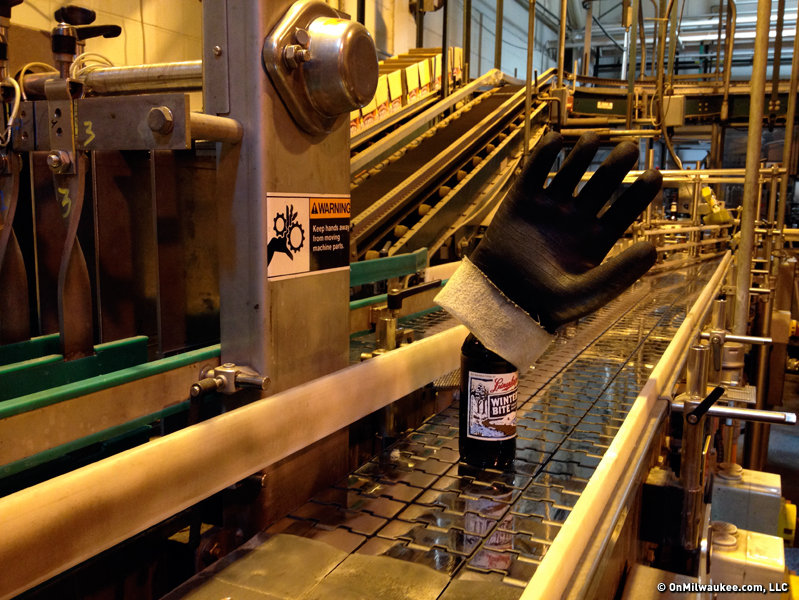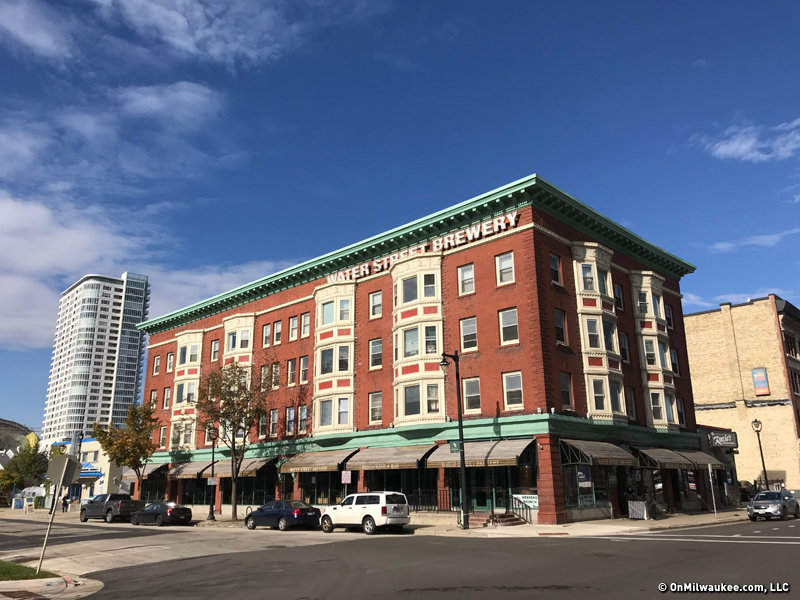Enjoy this look back at one of our favorite pieces! We continue to publish great new articles daily but will share some unique throwbacks to Milwaukee's (and our!) past.
"Uneasy" might be a good word to describe the feeling I experienced as Adam Spoerri and I stood in a subterranean beer storage cave – out of service for well over a century – on Milwaukee’s near South Side.
We had to traverse a low-ceilinged obstacle course of rusted and wet debris to get inside. Did I mention that course runs beneath four floors of caved-in building rubble? Yet walking into the remarkably preserved cream city brick cave with its barrel vault and cobbled floor was a revelation. Like stumbling into a Milwaukee secret, albeit a poorly kept one.
"You can see the sinkholes over there," Spoerri says, pointing down the long, dark cave to a couple spots where the ceiling and the earth above it have fallen into the cave. "We’re probably standing right underneath your car," he adds, referencing the pebbled area where I’d parked an hour earlier.
On the way back out, as we’re in the obstacle course attempting to avoid the rusty nails pointing upward, Spoerri says, "this is the part the City thinks will collapse at any minute." Despite his quiet, almost shy demeanor, Spoerri clearly has a sense of humor and a flair for the dramatic. I can’t see his face in the dark, but I hope he’s smirking.
Spoerri is a partner in the non-profit ReThink Factory, which works with groups like Sweet Water Organics and Urban Ecology Center a part of its mission to create more sustainable and resilient communities through a design/build education.
ReThink is working to envision and ensure a future for a rarely seen bit of Milwaukee brewing history. Where South 29th Street dead ends into the Menomonee Valley are the remains of Franz Falk’s Bavaria Brewery, the fourth largest brewer in the city in its day.
"The site is owned by Straightway Vineyard church and my organization ReThink Factory is trying to redevelop the site and turn it into a social innovation hub and education center," says Spoerri. "We are currently looking for support and partners is this incredibly large undertaking.
"It is also currently on the city's hit list," he adds, noting that the building is on the to-be-razed list. "But we are working towards fixing that. We were quite close to a historical designation but the Common Council put it on hold until we deal with some structural issues."
The buildings are clearly of value in a city whose reputation and historical identity is fueled by beer.
Falk – his family later went on to build the Falk manufacturing empire nearby – started his brewery with Frederick Goes in 1855, a mere seven years after arriving from Germany. In 1870, Falk’s brewery erected the earliest part of the Ice House – the building under which I’m standing with Spoerri. A few years later the only other extant brewery building – the stables – was constructed.
There were other buildings, but they were all lost amid numerous fires or were demolished over the years. One fire, on July 5, 1889, made national news. According to the city's historic designation report:
"The fire started in the malt house in the early afternoon. On duty were the in-house fire crew but most of the employees were off work. Unable to access the water from the artesian well, employees called upon the Milwaukee Fire department to help. By the time they arrived and set up at the river, the complex was engulfed in flames. The new boilers burst and the ammonia tanks used to make ice also exploded. The storehouse managed to survive although gutted as were the stables with their horses and wagons. Lost were the malt house, the brew house, the elevator, and the engine house with its expensive ice machine. Also lost was the office building. Only the vault was left standing.
"Although the storehouse survived, the 52,000 barrels of beer in storage there were ruined by heat. Some 50,000 bushels of damaged barley had to be sold off. Estimates for the damage ran from $700,000 to one million dollars. Insurance coverage was between $300,000 and $400,000. Other breweries offered their help to supply Falk, Jung & Borchert’s customers. The Jackson Sentinel mentioned that the physical and financial loss was the biggest in Milwaukee history up to that time."
That and a couple blazes a few years later doomed Falk’s brewery. Two in the space of three years caused financial distress that was impossible to overcome and Falk gave in and sold out to Pabst in an acquisition ($1 plus $500,000 in Pabst stock, along with jobs for the Falk execs) that made the Captain the city’s biggest beer baron and his brewery the world’s biggest, for a brief moment.
A third building on the site, the office (which was damaged by fire in 2019. -ed.), was built by the Borchert Malting Company, which purchased the property in 1897, continuing Falk’s on-site malting operation. Ernst Borchert was a partner in Falk. He took his parachute position with Pabst, leaving shortly after to get back into the malting game on familiar turf.
In 1919, Borchert sold to J.M. Riebs Malt and Grain Co., which did brewing, malting and distilling on the site until it, too, was taken down by fire in 1971. At the same time, the National Foundry Co. set up shop in the stables, which it expanded over the decades, until it was replaced by Schwerman trucking in 1956.
The site had a few small operations – tire recycling, salvage yard – until the church bought it in 2009. Spoerri says the church hopes to renovate and occupy the stables, while ReThink is currently rehabbing the office into its own headquarters.
But the gem of the site is the ice house complex – which had numerous additions in the 19th century. No one knows for sure who the architects of the building and its additions were, but some say Henry Koch, others suggest Henry Messmer and still others have reason to credit Chicago’s Griesser & Maritzen.
Regardless, the stables and the ice house are cream city brick structures with romanesque arches and in the case of the stables, some unusual and fetching occuli in the east and west facades. The interior of the stables boasts some pretty intricate and colorful graffiti art.
The office, meanwhile, is a colonial revival with fine woodwork, etched glass panels and the original paymasters’ counter. Work on that frame structure is underway. There are drawings of ideas for the brick buildings but they can’t move forward without a good chunk of change, which is never easy for a couple non-profits to raise.
When Spoerri invited me over to see, he made an offer I could hardly refuse.
"Two floors are only accessible by ladders and there are actually large shafts called waterfalls you could rappel down if you wanted. There is also an underground beer tunnel only accessible through a collapsed section of the building. We will be going up and down ladders and through small holes cut into the floors."
And that’s exactly what we did. We climbed ladders the likes of which I’d never ascend at home on my own and we shimmied through a couple holes hammered through floors (or ceilings, depending on which side you’re on). We peeked down those waterfalls and four flights down into the collapsed rubble of the 1870 building.
There are still huge malting vats, which we viewed from above, below and alongside. There is an amazing grain elevator with long narrow cups that ride up and down a belt in a boxed-in shaft. Above our heads are huge wheels that helped run machinery. In one giant room we can see the germination beds for malting.
Paint is peeling from most surfaces and stray lengths of old rope lie in heaps on the floors. Rusted metal tools and controls are here and there. Because the windows are covered, we have to carry flashlights to make our way around.
But what is most striking is the silence. It’s eerie to think of the activity that must have enlivened these rooms for decades; to think of the people who passed hours and days and years working in here for more than a century.
When we walked outside into the sunlight, Andy Tarnoff, who came along to take photographs said, "there are ghosts in my hair."
Ghosts of Milwaukee’s brewing past.
Born in Brooklyn, N.Y., where he lived until he was 17, Bobby received his BA-Mass Communications from UWM in 1989 and has lived in Walker's Point, Bay View, Enderis Park, South Milwaukee and on the East Side.
He has published three non-fiction books in Italy – including one about an event in Milwaukee history, which was published in the U.S. in autumn 2010. Four more books, all about Milwaukee, have been published by The History Press.
With his most recent band, The Yell Leaders, Bobby released four LPs and had a songs featured in episodes of TV's "Party of Five" and "Dawson's Creek," and films in Japan, South America and the U.S. The Yell Leaders were named the best unsigned band in their region by VH-1 as part of its Rock Across America 1998 Tour. Most recently, the band contributed tracks to a UK vinyl/CD tribute to the Redskins and collaborated on a track with Italian novelist Enrico Remmert.
He's produced three installments of the "OMCD" series of local music compilations for OnMilwaukee.com and in 2007 produced a CD of Italian music and poetry.
In 2005, he was awarded the City of Asti's (Italy) Journalism Prize for his work focusing on that area. He has also won awards from the Milwaukee Press Club.
He has be heard on 88Nine Radio Milwaukee talking about his "Urban Spelunking" series of stories, in that station's most popular podcast.







